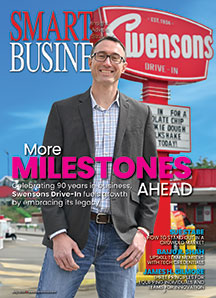Whether it is the pandemic, politics, business and the economy, or anything else in this information-laden age, we hope to have reliable and truthful accounts of things. Unfortunately, we are often confronted by conflicting opinions and stories that leave us confused and uncertain about what to believe. So, how to best make sense of it all?
Humor is often a good place to start. A recent Pepper & Salt cartoon in the Wall Street Journal showed a man on the witness stand with his hand on the Bible, stating, “I swear to tell my own truth … ” The humor is twofold: First, the traditional oath, “to tell the truth, the whole truth and nothing but the truth” is an impossible standard, and, second, that so much of what is presented as truth is subjective (“my own truth”). And if it’s only a truth for one person, how can it be relied upon in a court of law, in business, politics, or society at large?
Truth comes in many forms, including untrue truths — ideas that people may think are true but are not. How many forms of truth are there? It depends on how you break things down. For example, in “Truth: A History and a Guide for the Perplexed,” historian Felipe Fernandez-Armesto posits that truth has been discussed in four principal ways across the ages — that which you are told, that which you feel, that which you reason and that which you discover through the senses, with the latter being most formally recognized through scientific experimentation. Some things you are told are true, just as what you feel or reason about also may be true, or things you see or hear, but often what you are told is false, or you reason from false premises, and it’s not uncommon to be fooled by appearances.
Those four ways of thinking about truth have limitations. In “A Short History of Truth: Consolations for a Post-Truth World,” British philosopher Julian Baggini offers a practical approach by way of 10 types of truth: eternal truths, authoritative truths, esoteric truths, reasoned truths, evidence-based truths, creative truths, relative truths, powerful truths, moral truths and holistic truths. His intention is not to confuse us with too many distinctions but rather to help us understand the complexities of truth in our day-to-day activities. As a means of better coping with the inherent uncertainties what we read, think or say, he urges us to be skeptical without becoming cynical. In other words, by making those 10 distinctions, Baggini urges us to examine things critically and be curious and aware of the limitations inherent in various sources or accounts of events.
Take his notion of a creative truth and ask, how can that be a truth at all? He suggests that a declaration of intent, when followed by the actions necessary to accomplish that intent, make it a creative truth. That is what many leaders use to express a vision or goal, and that is what the German poet Goethe recognized when he penned,
“Whatever you can do, or dream you can, begin it. Boldness has genius, power, and magic in it.” (Anster translation)
Of course, an action that many would judge as boldness, others may judge it as arrogance. So, which is the truth?
As much as we may wish for certainty or reliable information, and as much as journalists say they search for truth, personal or journalistic accounts of events are fragmentary perspectives inherently layered with subjective, interpretive judgments.
The best we can hope for is that we are offered a good sampling of “slices of the truth”1 — and that we ensure that for ourselves by reading and listening broadly and critically.
Luis M. Proenza is President Emeritus of The University of Akron

